Early on Saturday morning, my wife and I headed out for some average spring weekend recreational activities. Well, at least our version of average. Our first destination was the Annual Northeast PEZ Collectors Gathering, the self-proclaimed “Largest Gathering of PEZ Collectors on the East Coast!” I’m not sure what sort of ranking system is in place to measure the size of gatherings of PEZ collectors on the East Coast, but it’s for damn sure that this assemblage is far more impressive in its enormity than numbers two and three.
We traversed the New Jersey Turnpike and I-95 for a little over two hours before we arrived at a Holiday Inn in Stamford, Connecticut. A small meeting room was bustling with an equally small contingency of collectors reveling in their love of novelty candy dispensers. Several dozen vendors displayed their wares on folding tables around the perimeter of the room and my wife and I browsed as we strolled slowly along the single aisle. While we are collectors (some may call us “organized hoarders”), we don’t collect PEZ, specifically. However, I did purchase a couple of interesting character-topped dispensers to display in my office at work and Mrs. Pincus made some bulk deals on merchandise with some other dealers. Approximately 50 minutes after our arrival, we were off to our next scheduled stop – Kensico Cemetery in Valhalla, New York.
A quick drive back across the state line took us to Valhalla, a quaint village formed at the end of the nineteenth century when the Bronx River was dammed as a source of water for the ever-growing population of New York City. The original town of Kensico, NY now lies at the bottom of the resulting Kensico Reservoir. The residents populated the new community and named it “Valhalla” after the heavenly paradise of slain warriors in Norse mythology. A fitting name, since Kensico Cemetery, occupying 460 acres, is home to almost as many dead tenants as there are living in the in town.
Over the past few years, my wife and I have visited our share of cemeteries, but Kensico boasts a noticeable amount of unusual monuments to the deceased. These stone memorials are a few of the striking sights that dot the sloping landscape.
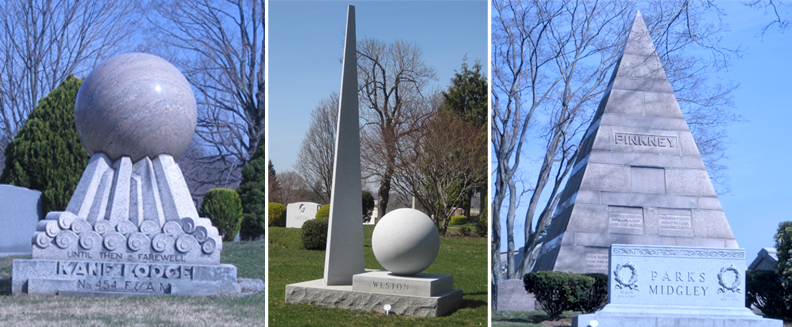
A recurring theme among grave markers at Kensico is the “Weeping Angel”. We saw quite a few variations of this emotional sculpture throughout the grounds Here’s one on the Madison family plot and perhaps there is another one here under wraps.
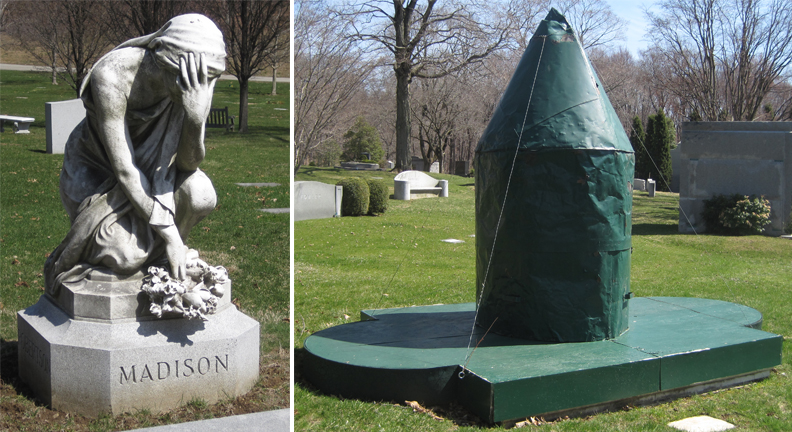
And the private mausoleums, while solemn for the most part, are not without the occasional light-hearted touch. Here, the DeRosa/Weingarten family express their sentiment for eternity.
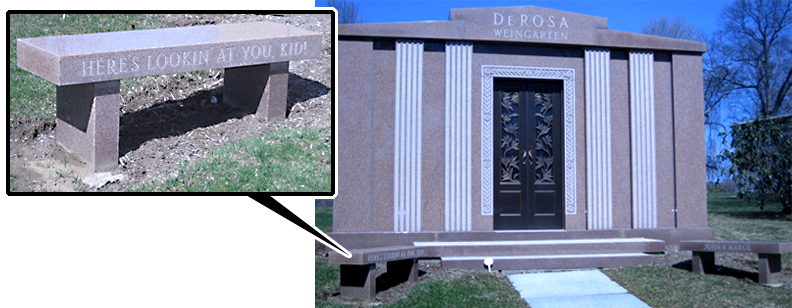
Armed with a map of the grounds, we drove up alongside the peaceful Mineola Lake and found a cement bench containing the cremated remains of entertainer Danny Kaye.
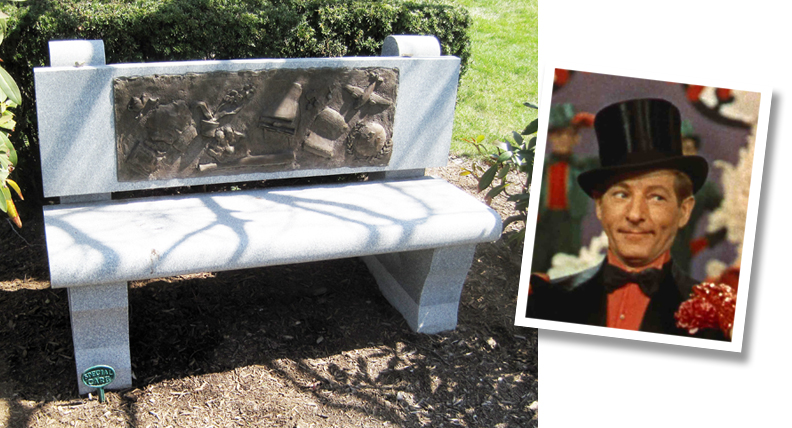
Danny was a versatile actor, adept at both drama and comedy. He is most famous for his roles in the films Hans Christian Andersen and the holiday classic White Christmas.
Just south of Danny’s memorial is the mausoleum of businessman Paul Bonwit, founder of Bonwit Teller department stores.
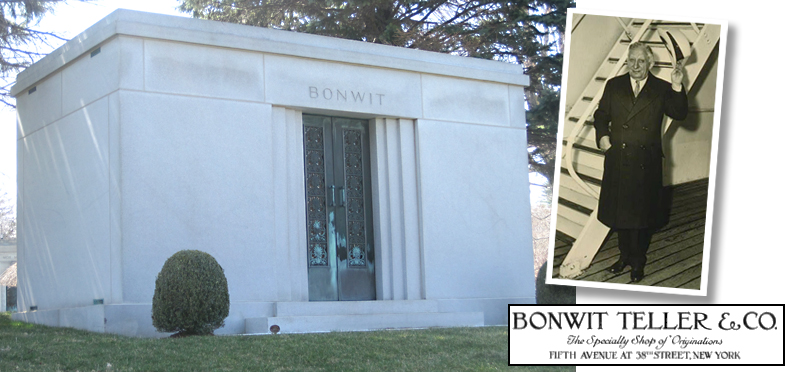
Nearby is a private mausoleum, with an elaborate stained glass backdrop, that serves as the final reward for David Sarnoff.
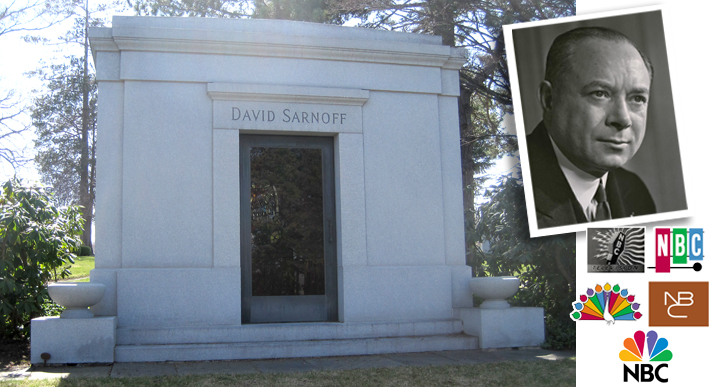
While working as an operator for the American Marconi Company, Sarnoff picked up the message that the S.S. Titanic had run into an iceberg and was sinking (a claim that, in recent times, has been disputed). When the Marconi Company was absorbed by RCA, Sarnoff became the company’s president and was instrumental in the founding of NBC. Later, he engineered the purchase of the Victor Talking Machine Company, the world’s largest manufacturer of phonograph records.
High on a hill above the Sarnoff mausoleum is the Lawrence family plot.
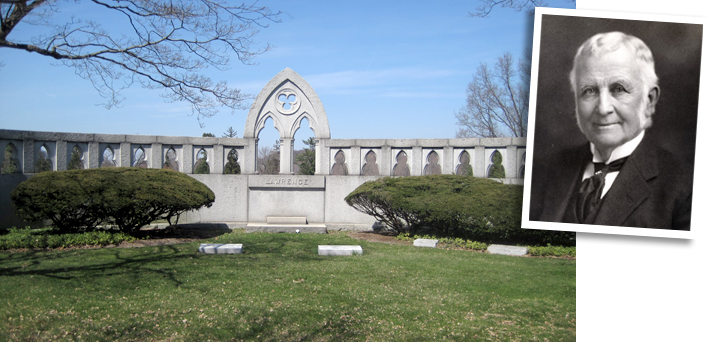
William Van Duzer Lawrence was the founder of Sarah Lawrence College, which he named after his wife. (Yes, her name was Sarah.)
A short drive led us the the twin plots of Tommy Dorsey and his fourth wife, Jane, a former dancer at the Copacabana nightclub in New York City.
Tommy fronted a popular big band in the 30s and 40s including two years with Frank Sinatra as the featured singer. In 1956, Tommy choked to death on his own vomit while he slept.
Right next to Tommy and his wife is the grave of Ayn Rand.
Rand, a writer and philosopher, was best known for her epic novels The Fountainhead and Atlas Shrugged.
Our next stop was the secluded garden plot of the Storrs family.
Frank Storrs earned his fame as the publisher of theatrical programs and builder of theaters. His family’s burial plot, with sculpture, glass-block lined reflecting pool and meticulous landscaping, is among the most beautiful in Kensico.
Past the Storrs plot reside two greats in New York Yankees history.
Lou Gehrig holds the major league record for career grand slams and his 2130 consecutive games record stood for 56 years. He was a six-time World Series champion, two-time MVP and seven-time All Star. On July 4, 1939, before a crowd of 61,808, Gehrig claimed to be “the luckiest man on the face of the earth” and retired at the young age of 36, due to a debilitating disease that eventually shared his name.
Near Gehrig is the mausoleum of Edward Barrow.
While manager of the Boston Red Sox, Barrow converted star pitcher Babe Ruth to a home run hitting outfielder. As manager, he won the last World Series the Sox would see for 86 years. He followed Ruth to New York and signed Lou Gehrig and later, Joe DiMaggio. All, including Barrow, are members of the Baseball Hall of Fame.
We were careful not to interrupt a nearby funeral attempting to see the graves of Florenz Ziegfeld and Billie Burke.
Ziegfeld was a renowned producer whose shows ruled Broadway for 36 years. His wife, actress Billie Burke, played Glinda the Good Witch in The Wizard of Oz.
This majestic structure is the resting place of the Ruppert Family.
Jacob Ruppert Sr. was a popular brewer in New York City. He died at age 74 from cirrhosis of the liver, stemming from years of tasting his own product. Son Jacob Ruppert Jr. inherited the business upon his father’s death and – as a wise investor and long-time baseball fan – purchased the New York Yankees. He signed pitcher Carl Mays and slugger Babe Ruth. In 1923, he built Yankee Stadium.
This monument, engraved with music notes, marks the grave of songwriter Peter DeRose. The inscription on the stone reads “Every friend he ever made, he kept.”
DeRose wrote popular songs like “Buona Sera,” “Marshmallow World” and “Deep Purple,” all recorded by numerous artists over the years. In 1968, guitarist Ritchie Blackmore’s grandmother repeatedly asked if his new band would be performing the song “Deep Purple.” He decided to name his band Deep Purple instead.
The massive carved memorial to Alfred Holland Smith sits nobly atop a hill.
Smith was the president of the New York Central Railroad. He died in 1924 when he was thrown from a horse in Central Park. He should have taken the train.
This mausoleum holds the remains of John Willys.
John Willys founded the Willys-Overland Automobile manufacturing company. From 1912 to 1918, Willys was the second largest producer of automobiles in the United States. The company’s best known product is the multi-terrain Willys MB, better known as the Jeep. During World War II, Willys produced 300,000 of them. The Grateful Dead paid homage to the vehicle in their song “Sugar Magnolia” with the lyric: “She can dance a cajun rhythm/jump like a Willys in four wheel drive.”
This unusual plaque adorns to headstone that marks the grave of Harriet Quimby.
Quimby was the first woman to obtain a pilot’s license in the United States. Less than a year later she became the first woman to fly across the English Channel. She died when she fell from the cockpit of her plane at an air show in 1912.
In the far end of the cemetery is the grave of actress Anne Bancroft.
Bancroft, a two-time Tony Award winner and many time Golden Globe nominee, was famous for her iconic role as the seductive Mrs. Robinson in The Graduate. She won an Oscar for her role as Ann Sullivan in The Miracle Worker and was nominated two more times for The Turning Point and Agnes of God. She was married to actor/writer/comedian Mel Brooks for 40 years until her death. (Note another “weeping angel” on top of Anne’s headstone.)
Cartoonist Peter Arno is buried beneath this stone that bears his signature.
Arno was a long-time contributor to the New Yorker magazine and, through his cartoons, coined the phrase “Back to the drawing board!”
A short drive ahead is the plot reserved for members of The Actor’s Fund. The Fund assists with the cost of funerals and provides a grave site with a head stone to those in need. Because space is at a premium, some grave sites are doubled and tripled-up (sometimes pairing actors with no relationship whatsoever) and the markers are noted accordingly. Some of the actors who took advantage of their services are:
John Call, who played Santa Claus in the camp classic Santa Claus Conquers the Martians.
Pat Harrington, Sr., primarily a Broadway actor, appeared in one film, 52nd Street. He was the father of Pat Harrington Jr, who played obnoxious superintendent “Schneider” on the sitcom One Day at a Time.
Vivian Blaine, who starred opposite Frank Sinatra in Guys and Dolls.
Guy Kibbee, who appeared in over 100 films as part of the Warner Brothers Stock Company through the 30s and 40s.
Richard B. Shull, a veteran character actor, best known for roles in Splash, Klute, the Billy Joel video for “Keeping the Faith” and as the human half on the sitcom Holmes and Yoyo.
and Sammy Petrillo, an actor and stand-up comic, who made a (minor) career of impersonating Jerry Lewis in the low-budget Bela Lugosi Meets a Brooklyn Gorilla opposite partner Duke Mitchell (doing his best Dean Martin impression). The team continued the act in nightclubs for years, much to the chagrin of the real Martin and Lewis.
Across from the Actor’s Fund is the grave of composer Sergi Rachmaninoff.
Rachmaninoff was the composer of Piano Concerto No. 2 and Prelude in C# Minor. Considered by many to be the only true Russian heir to composer Tchaikovsky’s romanticism, Rachmaninoff not only dazzled the world with his compositions but was also regarded by many as the finest pianist in his time. (In the film Willy Wonka and the Chocolate Factory, Mrs. Teevee identifies the tune played to open the musical lock as “Rachmaninoff.” However, it is not.)
At the foot of a narrow, sloping roadway is the community burial plot for the Benevolent and Protective Order of Elks, New York Lodge Number One. The area is guarded by a great bronze elk, of course.
In the same area is the large, pink granite marker of actress Judith Evelyn.
Judith performed on stage throughout the United States, but the roles she is most associated with feature no dialogue at all. She played “Miss Lonely Hearts,” one of the cast of characters observed by an immobile James Stewart, in Rear Window and the deaf mute wife of a devious theater owner in William Castle‘s The Tingler.
I spotted this monument and couldn’t resist a picture.
I guess things aren’t going so well since the heyday of MTV.
On the northeastern edge of the cemetery is the Friars Club plot. The Friars Club is a fraternal association of the entertainment industry, famous for their raucous celebrity roasts.The most famous interment in this area is the inimitable Soupy Sales.
Soupy Sales was a comedian, actor, disc jockey and TV pioneer, famous for his children’s sketch comedy show and making a “pie in the face” an art form. Some time ago, a friend, who was very close with Soupy, allowed me to “try my hand” at the original White Fang (as seen in the above photo – that’s my arm!)
The same friend recommended the Valhalla Crossing restaurant, just down the street from Kensico Cemetery.
Mrs. Pincus and I stopped in for an early dinner. The restaurant is made up of several converted train cars and the restored original Valhalla train station. It is very cool. (I understand that they are now open on Mondays.) While we were ordering, our waitress enlightened us about the history of the establishment and I made a smart-ass remark about something-or-other (the cole slaw, I think). The waitress smacked me. Actually, on purpose smacked me! My wife left her an extra generous tip.
We headed home.
* * * * *

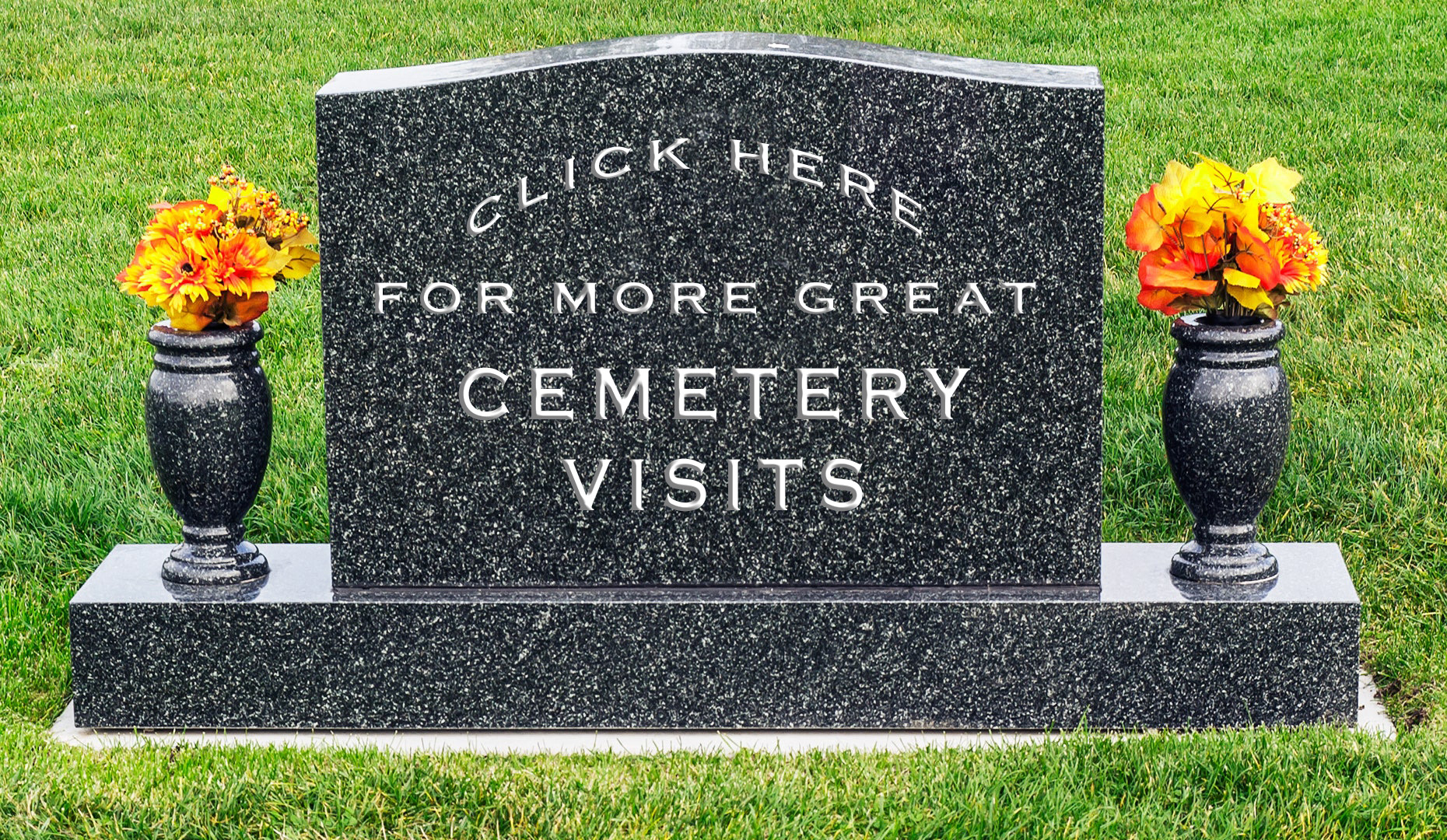
Josh, you should have been a writer. I love the detail you put into your pieces. They really captivate me. Thanks for entertaining us and giving us a history lesson.
It was very funny reading this after my sister gave me a complete rundown of her weekend at the PEZ convention, an annual trip for her family. She has quite a collection and was excited to have added a vending machine PEZ dispenser still in the box. I don’t think they’ve ever made their way to the cemetery, but hey there’s always next year!